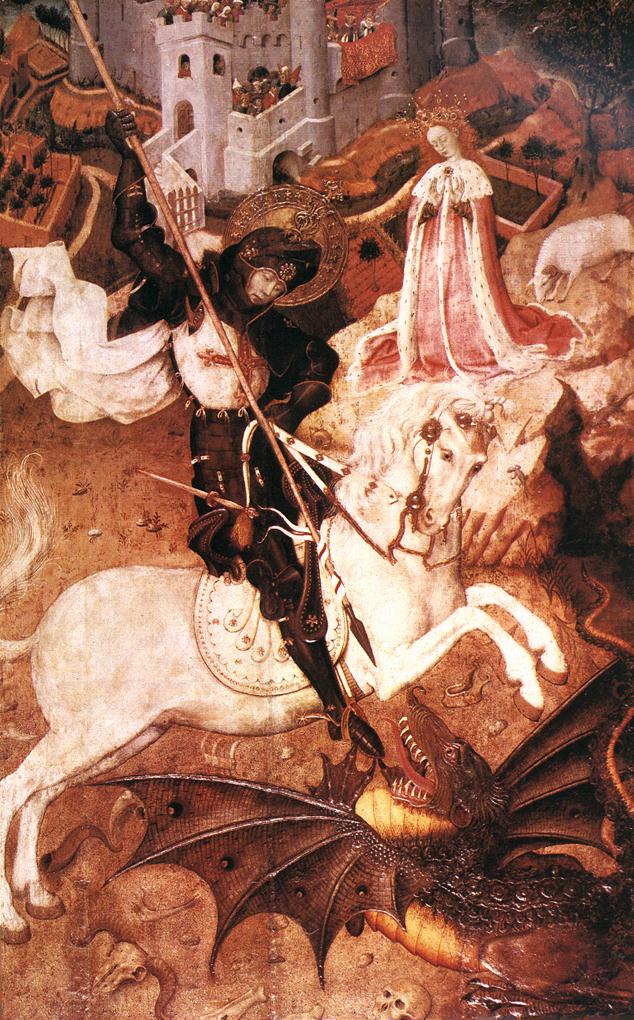
St George Killing the Dragon, Bernat Martorell, 15th century
Lecture 12. January 6, 1948
THE HERO AND THE PROPHET
A distinction exists between two types of human beings: the hero and the prophet, and the relationship between them is of primacy importance. In the hero, humanity has projected a symbol of physical man fighting the forces of the power of darkness.
The Bible contains all literary forms. It is the super-epic and it deals with the act of the hero. One of the key ideas is the struggle, with nature or with other men who symbolize the forces of nature. The development is the great archetype of the hero’s struggle with darkness, such as the dragon, and the victory of light over darkness at every sunrise. The solar symbolism here is exhaustive.
The Bible centres on a single heroic act: the struggle with darkness and the resultant victory. In medieval sculpture Jesus is pictured as dragon killer.
The hero, or king, is not fully conscious of what he is doing. The hero is illusive, inscrutable, and therefore commands loyalty. Christ as the suffering hero has that illusive quality. There is a feeling of the distant hero who proceeds to inevitable fate and triumph in the “heroic” Christ who says “touch me not.” The hero is too preoccupied with his action to know what he is doing, like Achilles brooding in his tent. The heroes are figures moving in a ritual, not in the myth, and they move with a silent and unconscious quality.
The other type is the prophet who, in a sense, is the opposite. He has the disinterested view of humanity, and yet is articulate. He is not known for physical perfectibility and is likely to be stunted or deformed. He is the observer, the watcher, which the king is not. The man who is both hero and prophet is such a schizophrenic that he can’t do anything.
The hero and the prophet are different. The hero is the actor, the prophet is the articulate person who explains the myth. The poet, then, is the prophet.
The hero is the centre of activity; the prophet is the circumference of activity—the whole range of experience is in his mind. The hero is always “somebody else,” while the prophet is identical with ourselves because we have to go into his mind and make contact. All through humanity, in practise the hero and the prophet are separate. But ideally they are the same. The hero’s inscrutability is because he knows what is going on. The prophet must be able to practice what he preaches.
The priest is the intermediary, neither prophet nor hero. He stands at the point at which the ritual and myth converge. The hero still triumphs but he will be killed. The prophet will become articulate but never causes. The poet who enters the social causal sequence contaminates himself. It is the priest who understands the myth and who performs the ritual. The thing done and the reason for it are understood by the priest.
The function of the hero is to die for his crusade, but it is not the function of the prophet to die unless he becomes the hero. Christ takes on aspects of prophet and king, and also priest, in the sense that he is the intermediary between man who suffers and a Father God who does not cause, although He has total comprehension.
Man begins his life in this world as weak; intelligence is weak and power is stupid. He tries to assign intelligence to the power around him. He thinks that lightning must be the power of a god with man’s intelligence but with more power.
The function of art is to sharpen human imaginative conception of the world. It is sharpened in epic, ballad forms which show the powers of darkness as dismal and stupid. The epic deals with the heroic act, human versus nature; that is, the physical world which presents itself to man as something to be overcome. Man tries to develop the garden out of the wilderness, a city out of rock and desert, a river out of the sea, form out of chaos.
Human Natural
Garden Wilderness
City Desert
River Sea
Intelligence Brutal power
Form Chaos
“Normal,” the norm Monstrous: power and chaos
of existence, what
is true of oneself
In Exodus, the two great heroes, Moses and Joshua, are concerned with a heroic act. Moses is true to the epic hero who struggles against the wilderness and dies at the summit of his achievement. The Promised Land is both city and garden. The story behind this is that of Israel (a single man) versus a wilderness which can become the Promised Land. When the prophets foretell of a prophet-king, they talk in terms of killing a dragon, Leviathan. Isaiah 51: 9–10: the conquest of the sea is something which Isaiah takes us to.
Awake, awake, put on strength O arm of the Lord; awake as in the ancient days, in the generations of old.
Art thou not it that hath cut Rahab and wounded the dragon? Art thou not it which hath dried the sea, and the waters of the great deep; that hath made the depths of the sea a way for the ransomed to pass over?
The dragon is a sea monster connected with the power of God which defeats the sea; he dries it up. Jesus’ ability to command the sea and still the tempest is part of this. Chap. 27: 1: “even Leviathan the crooked serpent . . . .” On the day of crisis, God will kill the dragon.
